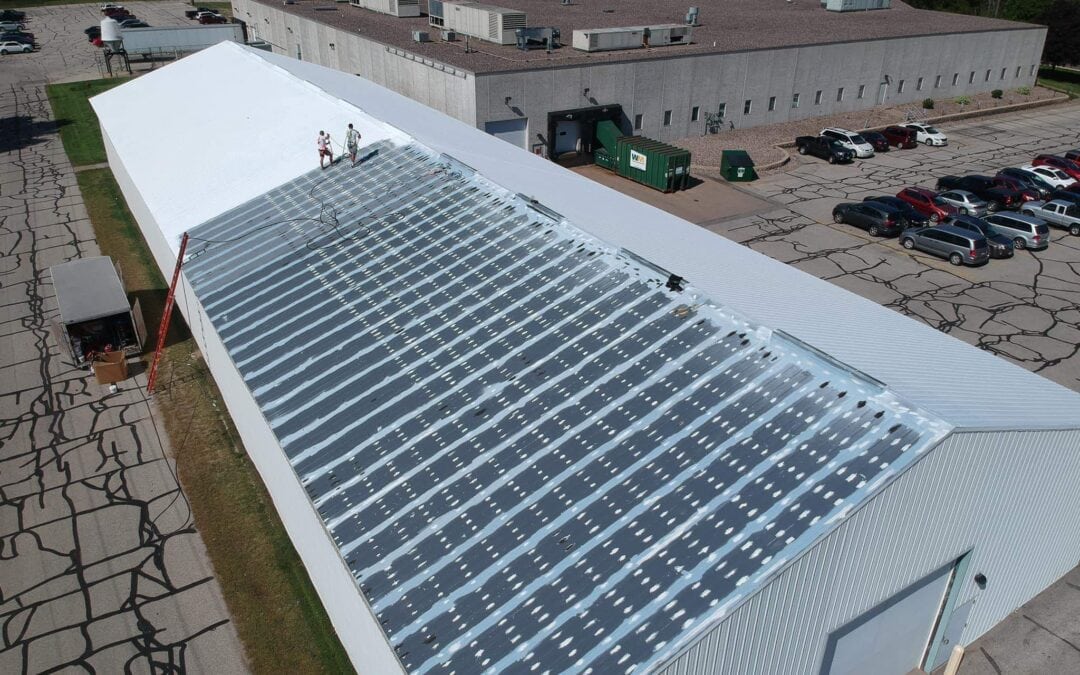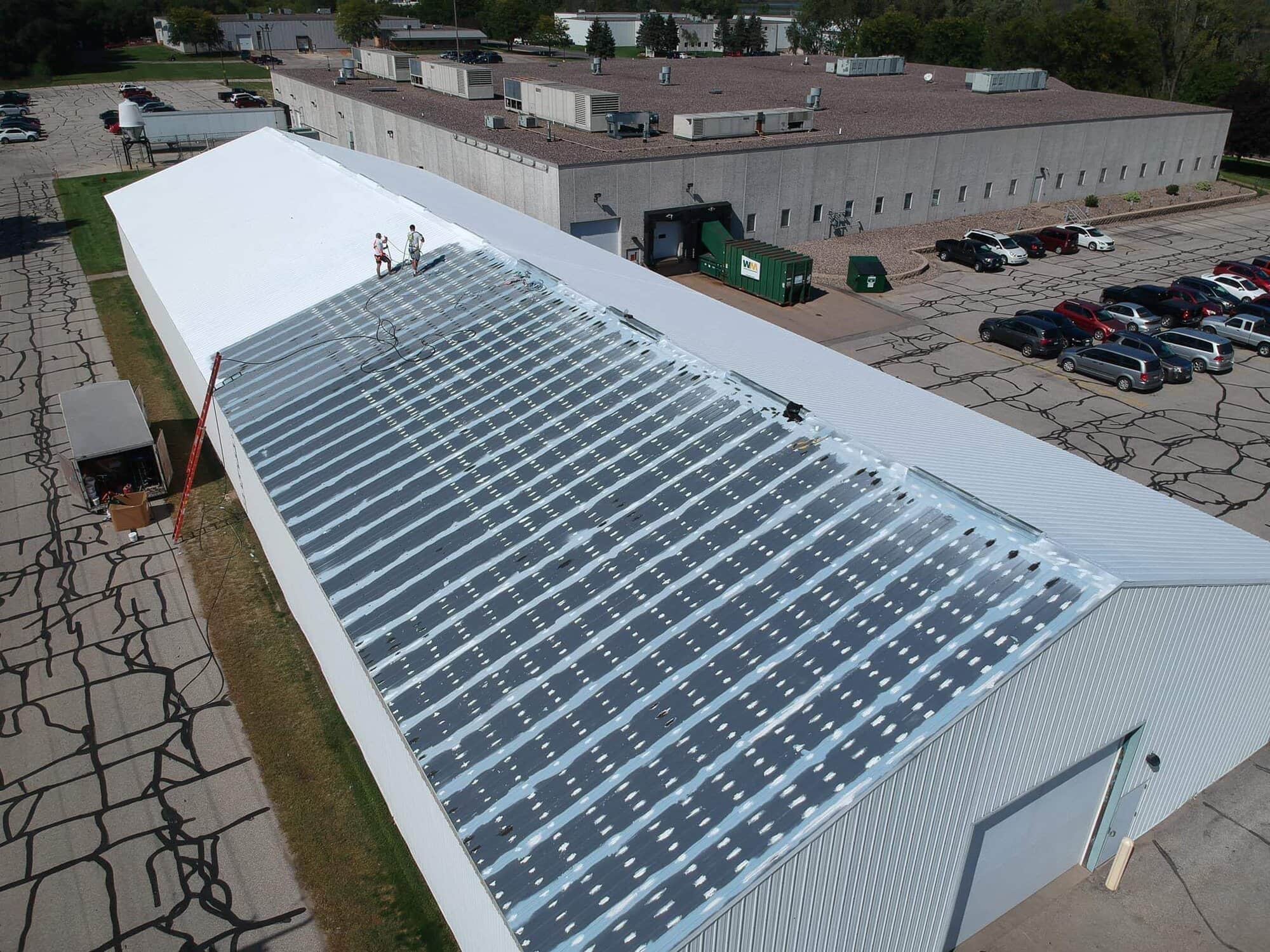
Drip, drip, drip. Another leak? Why do we get a leak each spring? After a winter with snow sitting on the roof, leaks pop up faster than the spring flowers when the temperature breaks freezing on a sunny day.
Spring poses unique risks to commercial roofs due to fluctuating temperatures. The quickly changing temperatures cause materials to expand and contract. This weakens fasteners, caulk, and seams while allowing melting snow to exploit these vulnerabilities [8][11]. However, with proper commercial roof maintenance leaks can be held off for many years.
What Are Leaks? Where Do Leaks Typically Appear?
Leaks occur when flaws or wear in your original roofing system allow water to penetrate the building.
Metal Roofs
For metal roofs, common leak culprits include:
- Seams
- Fasteners
- Rust & Pinholes
Seams are where the metal sheets overlap. When the seams are not properly sealed either due to incorrect installment or separation of seams over years of withstanding the weather, water leaks through [1][6].
Fasteners, or screws, create an entry point for water when a screw backs out, corrodes, or is missing [1][10].
Finally, rust, which naturally develops on metal roofs after years of use, weakens the metal’s integrity and leads to tiny holes called “pinholes” [1][6].
Rubber Roofs
For rubber roofs, common locations for leaks are:
- Edges and Seams
- Small Punctures
Edges are anywhere the rubber touches the roof or building itself, and seams are where the rubber touches itself. Anytime the temperature has large fluctuations, like in the springtime, the rubber expands and contracts. When the rubber expands and contracts, it pulls away from the edges of the building and from the seams which creates vulnerabilities that water takes advantage of [1][6].
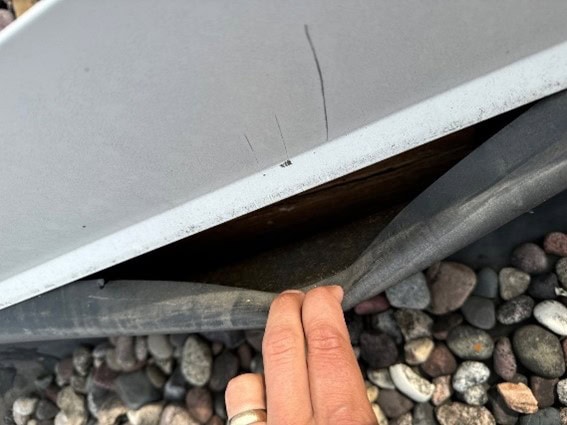
Figure 1: Rubber pulling away from edge of building
The other common cause of a leak in a rubber roof is puncture holes which are small holes in the rubber membrane. Puncture holes can usually be patched with caulk or rubber patches, but they can also be difficult to find since many rubber roofs are covered with up to 3” of rocks [6].
What Causes Leaks?
Weather
Leaks are commonly caused by rain, snow, hail, ponding water, and sun damage. Heavy rain reveals existing vulnerabilities such as pinholes, puncture holes, etc. Rain does not typically cause additional damage to a roof, but it does show where weaknesses in the roof already exist.
On the other hand, snow can cause cracks in metal and rubber roofs. Snow sits on the roof, melts enough to squeeze between a fastener and the metal or between a seam in either a metal or rubber roof and then freezes. When the snow freezes, it expands and causes a miniscule flaw to become a crack through which the melting snow seeps into the building [2][8].
Hail damage on rubber roofs splits rubber membranes and pierces its protective coatings leading to leaks. On metal roofs, hail damage causes pinholes and compromises protective coatings. Pinholes clearly cause a leak since they are a tiny hole in the roof, but why does it matter if the protective coating is scrapped?
Many protective coatings are in place to prevent rust as the metal roof ages and to protect rubber roofs from becoming brittle and cracking, but hail creates flaws in the protective coating exposing the metal and rubber to additional water and sun which eventually causes rust and cracks respectively [1][3].
Ponding water or standing water on flat roofs accelerates material degradation and promotes leaks. Ponding water is especially common in shaded areas because the sun can’t reach the pond to dry it out [1][3].
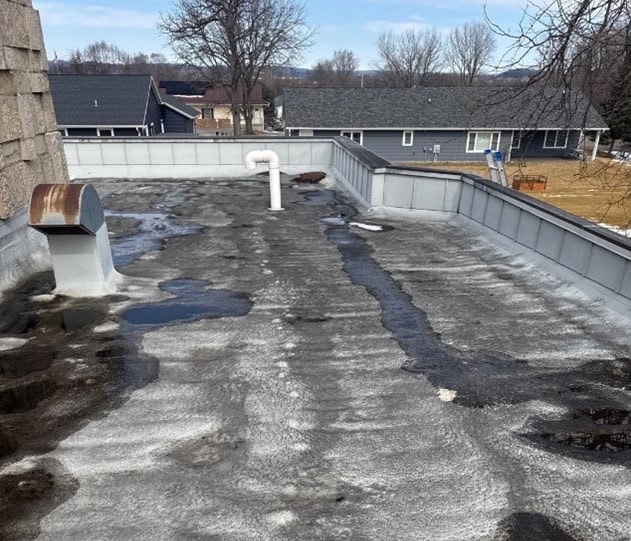
Figure 2: Ponding water
Lastly, sun damage occurs when UV rays break down roofing materials over time. UV rays along with the heat the sun brings cause brittleness and cracks, especially in rubber roofs and can also speed up the rusting process in metal roofs. [3][11]. Sun damage is one motivation for protective coatings on metal and rubber roofs because they provide additional protection against the heat and UV.
Temperature Changes
Temperature changes primarily affect rubber roofs and have less influence over metal roofs. Rubber expands and contracts significantly with temperature fluctuations, which stresses seams and edges. Metal roofs are less affected but still experience thermal movement that can especially loosen fasteners and seals over time [1][6].
One way to prevent vast temperature fluctuations, especially during hot summer months, is spray-on coatings which are white and thus reflect heat. Roofs without coatings are often burning hot to touch on a sunny day while roofs with white spray-on coatings are noticeably cooler.
Debris
Leaves, dirt, and other debris trap moisture on the roof. They can be trapped anywhere on the roof, but common places are gutters, ice dams, and ponding water which pools water, dirt, and debris and allows mold to grow. On metal roofs, debris promotes rusting. On rubber roofs, rubber membranes weaken with additional bacteria and debris that can get lodged in small crevices. Clogged gutters exacerbate water pooling and ice dam formation during winter [6][9].
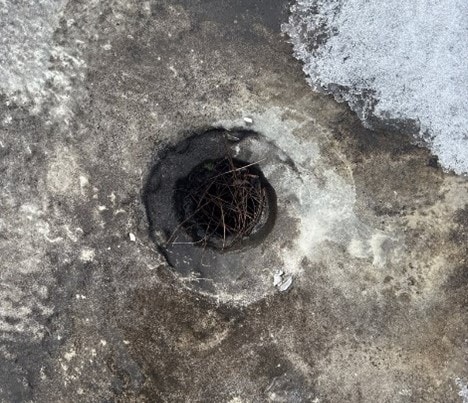
Figure 3: Debris in a drain
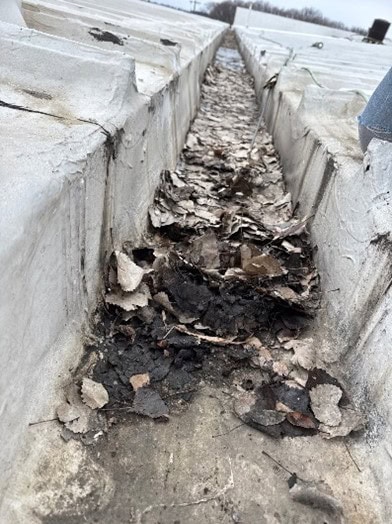
Figure 4: Debris in a gutter
At SR Commercial Roofing, we’ve seen firsthand how these weather conditions affect commercial roofs. Our expertise in spray-on solutions helps address these issues effectively.
How to Prevent Leaks
Regular Inspections
Inspect your commercial roof at least twice a year, once in the spring and once in the fall. If there is severe weather, throw in an additional. Look for loose fasteners, worn sealants, rubber pulling away from the wall, ponding water, and debris buildup [4][9].
Routine Commercial Roof Maintenance
Plan to regularly care for your roof. Even if your commercial roof maintenance is just conducted alongside your bi-yearly inspection, this maintenance can extend the life of your roof by years [1][6]:
- Clear gutters and remove debris regularly to prevent water from pooling.
- Tighten screws and replace corroded fasteners promptly to maintain structural integrity.
Professional Installation
Ensure proper installation of flashing, ridge caps, and fasteners to minimize vulnerabilities from the outset [1][10]. SR Commercial Roofing specializes in professional installation techniques that minimize vulnerabilities from the start.
- Protective Coatings: Consider fluid-applied roofing systems like spray polyurethane foam (SPF) (more commonly called spray foam) or other spray on coatings to comprehensively seal seams, fasteners, and other weak points [5].
Spray-on Roofing Solutions for Leak Prevention
Spray-on roofing systems, such as spray-on foam and spray-on coatings, offer unique benefits for leak prevention:
- Seamless application: Creates a continuous membrane that eliminates weak points
- Excellent insulation: Improves energy efficiency while protecting against temperature fluctuations
- Adaptable: Conforms to irregular roof shapes and easily covers fasteners and seams
- Durable: Resists UV radiation, chemicals, and physical damage
- Quick installation: Minimizes business disruption during application
These solutions are particularly effective at addressing common leak causes like seam separation, fastener issues, and pinhole formation.
Commercial Roof Leak Repair – Urgency?
The urgency of commercial roof leak repair depends on the building’s use. Critical facilities like food packaging plants must address leaks immediately. However, industrial sites with outdoor equipment may tolerate minor leaks temporarily.
One important consideration is: what’s your plan for commercial leak repair when the patches and caulk fail?
If you plan to replace it with a brand-new metal or rubber roof, you can use it until the leaks are not acceptable. But you will need to have a financial plan or savings in place for when the roof requires replacement.
However, if you plan to get a spray-on roofing system for leak prevention like we at SR Commercial Roofing install, spray-on systems like spray-on foam are viable only if the roof is in good enough condition for restoration (e.g. no extensive rust or structural damage) [5]. If the roof has deteriorated to the point that a person cannot walk on it, it is too late to opt for a roof repair or restoration using spray-on coatings. But spray-on roof coatings prevent leaks, protect the integrity of your original roof, are quickly installed, and are economical while still often lasting as long as a brand new metal or rubber roof.
If you’re not sure, give us a call at 608-844-4933, and we will give you a complimentary inspection and quote!
Concluding Thoughts
Spring leaks in commercial roofs are a common but preventable issue. Regular inspections, proper commercial roof maintenance, and innovative solutions like spray-on roofing systems are key to protecting your investment. By understanding the causes of leaks and taking proactive measures, you can ensure your commercial roof remains watertight and functional for years to come. Remember, addressing small issues promptly can prevent costly repairs down the line.
SR Commercial Roofing has been using spray-on roof coatings and spray-on foam as a commercial roofing solution to restore and repair commercial roofs with leaks for over 10 years. Call us at 608-844-4933 and let us know if you are interested in spray-on commercial roofing solutions as a durable, reliable, long term, and cost-effective solution to your roof’s leaks!
Citations:
[1] https://butlermfgparts.com/blog/metal-roof-leak-causes-and-fixes
[2] https://1800newroof.net/winter-roof-leaks-and-ice-dams-causes-and-solutions/
[3] https://roofingbylandmark.com/what-weather-conditions-have-the-biggest-effect-on-your-roof/
[4] https://distinctiveroofing.net/blog/roof-leak-repair/
[5] https://westroofingsystems.com/cannot-locate-leak-on-commercial-roof/
[6] https://eaglewatchroofing.com/metal-roof-repair/6-common-causes-of-metal-roof-leaks-repair-options/
[7] https://victors.com/blog/why-does-my-roof-leak-sometimes/
[8] https://calludk.com/blog/roof-leaks-during-winter/
[9] https://clearchoicedsm.com/roofing-blog/roof-leak-prevention-services-tips/
[10] https://www.americanweatherstar.com/5-common-causes-of-metal-roof-leaks-repair-options/
[11] https://www.billraganroofing.com/blog/ways-weather-impacts-roof
[12] https://www.servpro.com/resources/how-to-prevent-roof-leaks-commercial-property

